Edward S. Harkness was considered the most philanthropic of New York City's millionaires having donated countless millions and buildings to various charities and institutions. He had been born to Stephen V. Harkness and his wife Anna. On Stephen's death, Edward inherited some $50 million and he decided he wanted a suitable New York City residence for him and his wife, Mary. He chose a narrow plot that had been given to him by his mother and hired his friend, architect James Gamble Rogers, to design and build him a large townhouse.
Mary And Edward Harkness Were A Quiet, But Very Rich, Couple Who Gave Generously To The Poor
When the home was completed in 1908, it was a masterpiece, with 6 floors above ground and a basement below, it was a beautiful Italian Renaissance model.
The Beautiful Harkness Mansion, Once Completed, Became A New York City Tourist Attraction
The interiors, unlike most millionaire's homes, were designed for comfort and occasional entertaining. The ground floor held the reception room, dining room, entrance hall, pantry and the ladies powder room. The second floor held the two principal rooms, the library and the music room. The third floor held guest bedrooms and bathrooms, while the fourth floor held the Harkness's private suite. The remaining floors held servant accommodations and a few guest rooms.
The Entrance Hall Had A Rooster Statue In The Center
The Reception Room Was The Most Elegant Room In The House And Served As A Sitting Room
The Elegant Dining Room Could Seat 50 People And Had Two Service Closets On Either Sides Of The Fireplace
The Beautifully Carved Staircase Ran To The Very Top Of The House, All 6 Floors And Had A Glass Dome Covering It
The Staircase Had Decorative Iron Railing That Had Been Imported From Italy And Reinstalled In The Harkness Mansion
The Music Room Was Used For Restrained Recitals And Also Was Occasionally Used As A Ballroom
The Music Room Also Held Several Pieces Of The Harkness's Famous Art Collection And Statuary
The Second Floor Gallery Also Held Several Pieces Of The Harkness's Art Collection And It Was Done In French Paneling
The Library Was Used By Both Edward And Mary As A Retreat From The Uptight World Of New York City Society
The house's many bedrooms were each designed in a different style and each had their own bathroom and dressing room. Mr. and Mrs. Harkness's private suite was like that of an apartment. They shared a bedroom and they each had their own bathroom, dressing room and Mrs. Harkness's boudoir and Mr. Harkness's private den.


Not surprisingly, Edward Harkness was a Republican and he socialized with other prominent men such as, Stuyvesant Fish, Cornelius Vanderbilt II, William B. Astor Jr., James L. Van Alen, Arthur Curtiss James and Ogden Mills at Republican events and fundraisers.

.jpg)
The Republican Society Men Rallied Against Fellow Society Democrats, August Belmont, John Astor III, Thomas Ryan Fortune, William C. Whitney And Hermann Oelrichs. They Helped To Raise Money To Put An End To Boss Tweed's "Tweed Ring", Which Was Shot Right In The Heart By Republican Henry Clews's "Committee Of 70", And Teamed With Their Fellow Republican Society Women Such As, Mrs. Stuyvesant Fish, Mrs. Hermann Oelrichs (She Was A Republican Despite The Fact That Her Father And Husband Were Democrats), Maude Wetmore And Mrs. Henry Clews Sr. To Help Keep New York City And Newport Republican Cities.
When Anna Harkness died, she was reported to be one of the wealthiest women in the world, with a fortune of $107 million, out of which Edward inherited $93 million. Before Anna's death, she and Edward had paid two of the ten highest income taxes in the country. When Edward's brother, Charles W., died he left an estate of $60 million, out of which $36 million went to Edward. On Edward's death in 1940, he left an estate of $100 million, out of which Mary inherited life residency of all of their homes, along with some $10 million. Mary continued to live there and at their two other residences, "Eloma" in Connecticut and "Weekend" their Long Island estate.
"Eloma" (Top) And "Weeekend" (Bottom) Were Quiet And Comfortable Estates, With Comfortable Interiors And Comfortable Rooms
Mary continued to reside there until her death, 10 years later, upon which the home was donated to The Commonwealth Fund, which occupies it today.






































































.jpg)








